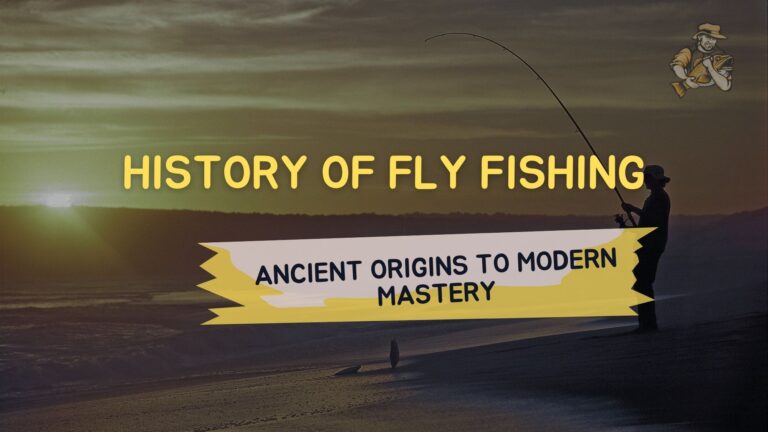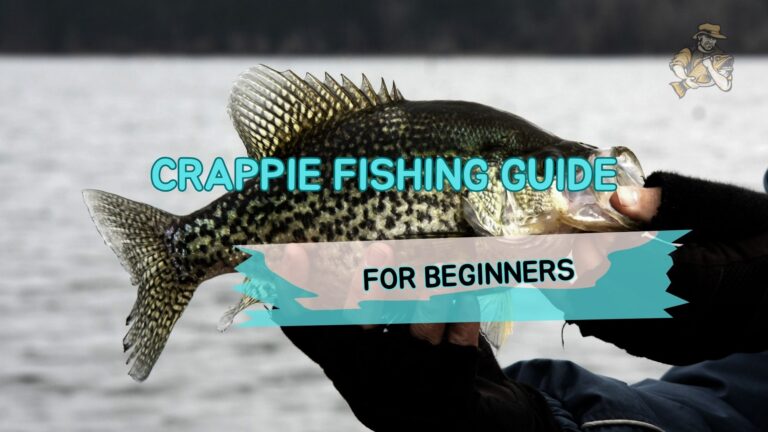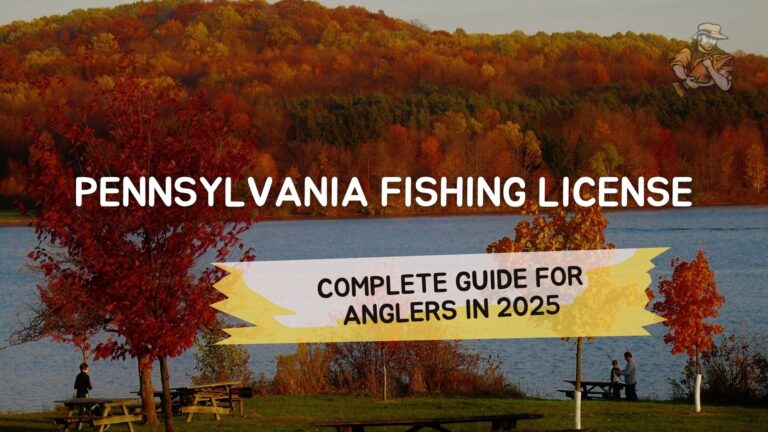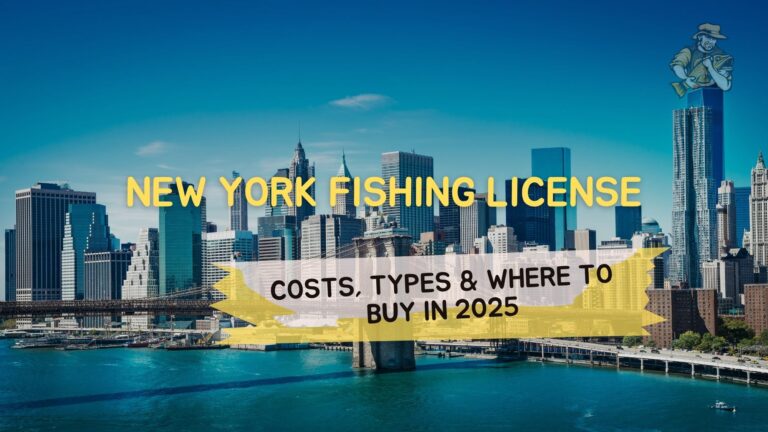California Fishing License Guide: Costs, Types & How to Buy (2025)
By Adam Hawthorne | Last Modified: April 26, 2025

Getting your California fishing license might seem like a hassle, but it’s actually pretty straightforward once you know the ropes. I’ve been fishing across North America for over 30 years, and I can tell you that California’s licensing system is fairly user-friendly compared to some other states I’ve dealt with.
Understanding California Fishing License Requirements
California requires anyone 16 years or older to have a valid fishing license when taking fish, mollusks, crustaceans, invertebrates, amphibians, or reptiles in California waters. This applies to pretty much all fishing activities, whether you’re freshwater fishing in lakes and rivers or saltwater fishing along the coast.
I learned this lesson the hard way many years ago. I was visiting a buddy in Southern California and thought I could get away with a quick fishing session at a local pier without a license. A friendly game warden quickly educated me on California regulations – and thankfully just gave me a warning instead of the hefty fine I deserved!
The California Department of Fish and Wildlife (CDFW) manages all fishing licenses in the state. They use the revenue from license sales to fund conservation efforts, habitat restoration, and fish stocking programs. So when you buy a license, you’re actually helping preserve those amazing fishing spots for future generations – something I’ve become increasingly passionate about as I’ve gotten older and seen how our waterways have changed.
Who Needs a License
Almost everyone needs a fishing license in California, with a few notable exceptions:
- Children under 16 years old
- Adults fishing on California’s Free Fishing Days (typically the first Saturday in July and September)
- Individuals fishing from public piers in ocean or bay waters
- Low-income seniors with a benefits card who are 65 or older
That pier fishing exception trips up a lot of people. It only applies to public piers in ocean or bay waters – not lakes, rivers, or private piers. And you still need to follow all the other fishing regulations when fishing from these piers.
My son first learned to fish when he was 12, and it was nice not having to worry about a license for him. We could just focus on teaching him to cast properly and identify different fish species. For his 16th birthday, I actually got him his first annual California fishing license – sort of a fishing family rite of passage.
California Fishing License Types and Costs
California offers several different types of fishing licenses depending on your needs. The prices tend to increase slightly each year, so these are approximate costs for 2025.
Resident Licenses
If you’ve established permanent residency in California, you qualify for resident rates. You’ll need to provide proof of residency when purchasing.
- Annual Sport Fishing License: Around $54-58 for the calendar year
- One-Day Sport Fishing License: About $17-18
- Two-Day Sport Fishing License: Approximately $27-29
- Ten-Day Sport Fishing License: Roughly $54-57
The one-day license can be a good option if you’re just making a quick fishing trip. But honestly, if you’re planning to fish for more than 3-4 days throughout the year, the annual license quickly becomes the better value.
Non-Resident Licenses
For visitors or those who haven’t established California residency, you’ll pay a bit more:
- Annual Sport Fishing License: Around $145-150
- One-Day Sport Fishing License: About $17-18 (same as resident)
- Two-Day Sport Fishing License: Approximately $27-29 (same as resident)
- Ten-Day Sport Fishing License: Roughly $54-57 (same as resident)
I’ve noticed California doesn’t charge non-residents extra for short-term licenses, which is nice when I take fishing trips to the state. Some other states really sock it to out-of-state anglers even for short visits.
Special Licenses
California also offers reduced-fee licenses for certain groups:
- Reduced-Fee Sport Fishing License for Disabled Veterans: About $8-9
- Reduced-Fee Sport Fishing License for Recovering Service Members: About $8-9
- Reduced-Fee Sport Fishing License for Low-Income Seniors: About $8-9
Back in 2019, I took my father-in-law fishing in the Sierras. He’s a Vietnam vet and qualified for the reduced-fee license. The savings weren’t huge, but he appreciated the acknowledgment of his service.
Additional Cards and Validations
Here’s where things get a bit more complicated. Depending on what you’re fishing for, you might need additional validations:
- Ocean Enhancement Validation: About $5-6 (required when fishing in ocean waters south of Point Arguello)
- Second-Rod Validation (freshwater only): Around $15-16
- Steelhead Report Card: Approximately $8-9
- Sturgeon Fishing Report Card: Around $9-10
- Spiny Lobster Report Card: About $10-11
- North Coast Salmon Report Card: Roughly $7-8
- Abalone Report Card: Currently not available due to fishery closure
If you’re planning to fish for salmon in rivers along the north coast, you’ll need both a fishing license and the North Coast Salmon Report Card. Same goes for steelhead – you need the special report card along with your license.
How to Purchase a California Fishing License
There are three main ways to get your California fishing license:
Online Purchase
The quickest and easiest way to get your license is through the California Department of Fish and Wildlife’s online license sales website. I typically go this route when planning fishing trips to California.
- Create an account or log in to your existing account
- Select the type of license you want
- Pay with a credit/debit card
- Print your license or save a digital copy on your mobile device
Just make sure you do this before you head out to the water. I’ve seen people trying to buy licenses on their phones with spotty reception at the lake – not a great way to start your fishing day!
Authorized License Agents
Many sporting goods stores, bait shops, and even some big-box retailers are authorized to sell fishing licenses. Places like Big 5 Sporting Goods, Bass Pro Shops, and local tackle shops can usually hook you up with a license.
When I was fishing Lake Tahoe last fall, I realized my license had expired. Luckily, there was a small bait shop near the marina that sorted me out in about 10 minutes. The shop owner also gave me some great tips about where the fish were biting that day. That’s one advantage of buying in person – local knowledge!
CDFW License Sales Offices
You can also purchase licenses directly from California Department of Fish and Wildlife offices located throughout the state.
This isn’t usually the most convenient option since they’re only open during business hours, but sometimes the staff can provide really detailed information about local regulations that might not be obvious from reading the handbook.
What You Need to Purchase
When buying a California fishing license, you’ll need:
- A valid identification (driver’s license or state ID)
- Your social security number (for first-time buyers)
- Proof of residency (if purchasing a resident license)
- Payment method
The first time I bought a California license, I didn’t realize they’d need my social security number, and it delayed the whole process. Now I always make sure I have everything ready before I start the application.
Special Requirements and Report Cards
California has some unique reporting requirements for certain species. These are designed to help monitor and manage fish populations.
Report Cards
Report cards are required for:
- Steelhead
- Sturgeon
- Spiny lobster
- North Coast salmon
You need to record your catch information on these cards and return them to CDFW by the deadline (even if you didn’t catch anything or didn’t fish). You can submit them online or by mail.
I nearly got in trouble once because I forgot to submit my steelhead report card on time. The next year, I couldn’t buy a new card until I submitted the old one and paid a small late fee. Now I set a reminder on my phone to submit these before the deadline.
Ocean Enhancement Validation
If you’re planning to fish in ocean waters south of Point Arguello (in Santa Barbara County), you’ll need to purchase an Ocean Enhancement Validation in addition to your fishing license.
This validation helps fund the enhancement of saltwater sportfishing opportunities in these southern California waters.
Free Fishing Days and Exceptions
California typically offers two Free Fishing Days each year – usually the first Saturday in July and the first Saturday in September. On these days, anyone can fish without a license, though all other fishing regulations still apply.
I took advantage of this a few years back to introduce my neighbor’s kids to fishing. They weren’t sure if they’d enjoy it, so the free day was a perfect opportunity to let them try without investing in licenses. They ended up loving it, and now they’re avid anglers with their own gear.
As I mentioned earlier, there are a few other situations where you don’t need a license:
- Children under 16
- Fishing from public piers in ocean or bay waters
- Fishing on a free fishing day
But remember, even if you don’t need a license, you still need to follow all other fishing regulations like bag limits, size restrictions, and season dates.
California Fishing Regulations to Know
While this guide focuses on licenses, it’s important to understand that California has some pretty specific fishing regulations that vary by region, water body, and species.
Bag and Size Limits
California has strict bag limits (how many fish you can keep) and size limits (how big the fish must be to keep) that vary widely depending on the species and location.
For example, the limits for California halibut are different than those for largemouth bass, and the regulations for the Colorado River might differ from those for the Sacramento River.
I always check the regulations for wherever I’m planning to fish before I head out. One time I was fishing for striped bass in the Delta, and another angler pointed out that the size limit had changed from what I remembered. That saved me from potentially keeping an undersized fish!
Gear Restrictions
Some waters have specific gear restrictions, such as:
- Barbless hooks only
- Artificial lures only (no live bait)
- Single hooks only (no treble hooks)
These restrictions are usually in place to protect sensitive fish populations or to promote catch-and-release practices.
When my son and I were fishing on the upper Sacramento River, we had to use barbless hooks due to the regulations for that section of the river. It took us a little while to get used to them, but it was actually great practice for improving our fish-fighting skills since you can’t rely on the barb to keep the fish hooked.
Seasonal Closures
Many fisheries in California have seasonal closures to protect spawning fish or to manage fishing pressure.
For instance, many trout streams are closed during certain months to protect spawning fish. It’s vital to check if the water you plan to fish is open during your visit.
I found this out the hard way when planning a fishing trip to a small mountain stream only to discover it was closed for the season. Always check before you go!
Fishing in California State Parks
Many of California’s best fishing spots are located within state parks. While your fishing license covers you to fish in these areas, you may need to pay a separate entrance or parking fee for the park itself.
Some parks also have specific fishing regulations that may differ from the general statewide rules. For example, some parks only allow fishing in certain designated areas or have special catch-and-release requirements.
I took Finn (my trusty black Lab) to Crystal Cove State Park near Laguna Beach last summer, and while I could fish with my regular license plus ocean enhancement validation, we had to pay a day-use fee to access the park itself. The extra cost was worth it though – beautiful views and some decent surf fishing.
Tips for Successful and Legal Fishing in California
Based on my experiences fishing throughout California, here are some tips to ensure you stay legal and have a great time:
- Always carry your license: Keep it on you whenever you’re fishing, either as a physical copy or a digital version on your phone. Game wardens can check at any time.
- Check regulations before each trip: Regulations can change, and different waters have different rules. The CDFW website has current information, or you can pick up a fishing regulations handbook when you buy your license.
- Download the CDFW mobile app: The California Department of Fish and Wildlife has a useful app that can help you check regulations, record catches, and even buy licenses.
- Consider joining a local fishing club: Local knowledge is invaluable, and fishing clubs often have members who know the local waters intimately.
- Respect private property: Always get permission before fishing on or accessing waters through private property.
- Practice catch and release when appropriate: If you’re not planning to eat your catch, consider releasing it to support sustainable fishing.
- Report fishing violations: If you witness illegal fishing activities, you can report them to CalTIP at 1-888-334-2258.
I’ve found that game wardens in California are generally helpful and educational rather than just looking to write tickets. Last year at Lake Shasta, a warden checked my license and then ended up giving me some great tips about where to find the kokanee salmon that were running at the time.
Is a California Fishing License Worth It?
With rising costs, some people wonder if getting a license is worth it. From my perspective, absolutely yes.
First, it’s the law, and the fines for fishing without a license far exceed the cost of buying one. Fines can run upwards of $500 for a first offense.
Second, the money goes toward conservation efforts that help ensure fishing remains good for years to come. As someone who’s been fishing for over three decades, I’ve seen firsthand how proper management can restore and maintain healthy fisheries.
And finally, California offers such diverse fishing opportunities – from high mountain trout streams to deep sea fishing – that even if you only go a few times a year, it’s worth having the proper license.
I remember taking The Patience (my small fishing boat) out on Clear Lake a few years back and landing several nice bass over the course of a weekend. That single trip made the annual license worth every penny.
FAQ About California Fishing Licenses
Do seniors need a fishing license in California?
Yes, seniors need a fishing license in California. However, eligible low-income seniors age 65 or older can qualify for a reduced-fee license. You’ll need to provide proof of eligibility through specified benefit programs.
Can I fish in the ocean without a license in California?
You can fish in the ocean without a license only if you’re fishing from a public pier. For all other ocean fishing (from beaches, jetties, kayaks, boats, etc.), you need a valid fishing license. If fishing south of Point Arguello, you’ll also need an Ocean Enhancement Validation.
I’ve had friends visit from out of state who were surprised to learn they could fish from the pier without a license. We spent a fun afternoon at the Santa Monica Pier catching mackerel and watching the sunset.
Do I need a separate license for freshwater and saltwater in California?
No, California’s basic fishing license covers both freshwater and saltwater fishing. However, you may need additional report cards or validations depending on the species you’re targeting or where you’re fishing.
How do I replace a lost California fishing license?
If you lose your license, you can get a replacement through the CDFW online license sales website, at a CDFW license sales office, or through a license agent. There’s typically a small fee for replacement.
Can I get a refund if I don’t use my fishing license?
Generally, no. California fishing licenses are non-refundable. This is why it’s important to consider which type of license will work best for your needs before purchasing.
Do I need a license to go fishing with my child if I’m not fishing myself?
No, if you’re merely assisting a child under 16 and not fishing yourself, you don’t need a license. However, if you plan to cast the line or reel in fish yourself, even occasionally, you should have a valid license.
Where does the money from fishing licenses go?
The revenue from California fishing license sales goes to the California Department of Fish and Wildlife for conservation programs, habitat restoration, fish stocking, research, and education. It’s an important source of funding for maintaining healthy fish populations.
Can I buy a California fishing license as a gift for someone else?
Yes, you can purchase a fishing license as a gift, but you’ll need the recipient’s personal information, including their date of birth, physical characteristics, and contact information. For first-time license buyers, you’ll also need their Social Security Number.
Conclusion: California Fishing Licenses
Getting a California fishing license is pretty straightforward once you understand the options. Whether you’re a California resident or just visiting, there’s a license type that will work for your needs and budget.
I’ve found that the process has gotten easier over the years, especially with the online purchase option. And while no one loves paying fees, knowing that the money supports conservation efforts makes it easier to swallow.
So get your license, grab your gear, and enjoy some of the most diverse fishing opportunities in the country. From the trophy trout in the eastern Sierra to the yellowtail off the southern coast, California has something for every angler.
And remember, it’s not just about staying legal – it’s about doing your part to ensure great fishing for generations to come.
When I first started fishing in California decades ago, I was mainly focused on not getting a ticket. But now, after seeing how license fees have helped restore fisheries and improve access, I see my annual license purchase as an investment in the sport I love.
Hope to see you on the water sometime!

Meet Adam Hawthorne
I’m a lifelong fishing enthusiast who’s spent years exploring rivers, lakes, and oceans with a rod in hand. At Fishing Titan, I share hands-on tips, honest gear reviews, and everything I’ve learned about fish and ocean life, so you can fish smarter and enjoy every cast.
Share:

Meet Adam Hawthorne
I’m a lifelong fishing enthusiast who’s spent years exploring rivers, lakes, and oceans with a rod in hand. At Fishing Titan, I share hands-on tips, honest gear reviews, and everything I’ve learned about fish and ocean life, so you can fish smarter and enjoy every cast.
Related Articles

History of Fly Fishing: Ancient Origins to Modern Mastery
The gentle art of fly fishing has captivated anglers for centuries, evolving from a practical method of obtaining food to a beloved recreational pursuit with…

Crappie Fishing Guide for Beginners | 2025
Crappie fishing might just be one of the most rewarding experiences for new anglers. These popular panfish are abundant, delicious, and put up a surprisingly…

Pennsylvania Fishing License: Complete Guide for Anglers in 2025
Getting your Pennsylvania fishing license sorted isn’t exactly the most exciting part of fishing, but it’s absolutely necessary if you want to stay on the…

New York Fishing License: Costs, Types & Where to Buy in 2025
Figuring out fishing licenses can be a headache, especially when you’re just eager to get out on the water. Over my years of fishing throughout…
